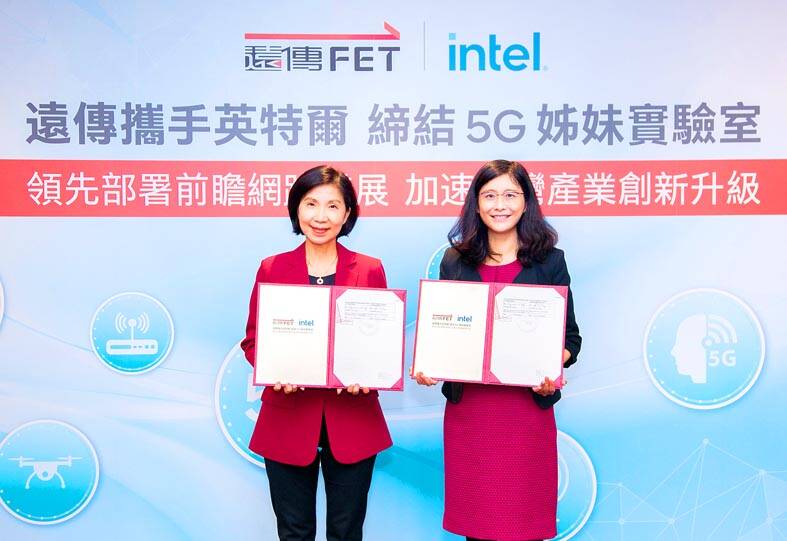Far EasTone Telecommunications Co (遠傳電信) has signed an agreement with Intel Taiwan to jointly research 5G open virtualized radio access networks (ORAN), computer vision and private cellular networks, Far EasTone said in a statement yesterday.
The two companies would pool their 5G know-how to boost network capacity and offer better user experiences for individual and corporate clients, Far EasTone said.
The ORAN-related research would involve developing plans to enable access to experimental networks, and sharing testing systems, software and hardware, it said.

Photo courtesy of Far EasTone Telecommunications Co
The Taipei-headquartered telecommunications firm said Intel would provide access to its Intel Smart Edge Open software toolkit for the project.
Far EasTone said it would also employ Intel’s Early Access Program to incorporate computer vision in smart city and transportation applications.
The two companies would work to incorporate their most advanced technology into digital health, smart manufacturing, and industry 4.0 applications to drive industrial upgrades in Taiwan, Far EasTone said.
Far EasTone president Chee Ching (井琪) said the firm has long endeavored to integrate and employ technologies central to 5G, including big data, artificial intelligence and Internet of Things applications.
Grace Wang (汪佳慧), vice president of Intel Taiwan’s sales and marketing group, said the Early Access Program would enable Far EasTone to develop edge computing and other Internet applications.
Under the agreement, Intel Taiwan would offer access to software such as Intel Geti and the Open Vino toolkit to help Far EasTone develop solutions for corporations to better adopt computer vision in their day-to-day operations, Wang said.

UNCERTAINTY: Innolux activated a stringent supply chain management mechanism, as it did during the COVID-19 pandemic, to ensure optimal inventory levels for customers Flat-panel display makers AUO Corp (友達) and Innolux Corp (群創) yesterday said that about 12 to 20 percent of their display business is at risk of potential US tariffs and that they would relocate production or shipment destinations to mitigate the levies’ effects. US tariffs would have a direct impact of US$200 million on AUO’s revenue, company chairman Paul Peng (彭雙浪) told reporters on the sidelines of the Touch Taiwan trade show in Taipei yesterday. That would make up about 12 percent of the company’s overall revenue. To cope with the tariff uncertainty, AUO plans to allocate its production to manufacturing facilities in

Taiwan will prioritize the development of silicon photonics by taking advantage of its strength in the semiconductor industry to build another shield to protect the local economy, National Development Council (NDC) Minister Paul Liu (劉鏡清) said yesterday. Speaking at a meeting of the legislature’s Economics Committee, Liu said Taiwan already has the artificial intelligence (AI) industry as a shield, after the semiconductor industry, to safeguard the country, and is looking at new unique fields to build more economic shields. While Taiwan will further strengthen its existing shields, over the longer term, the country is determined to focus on such potential segments as

COLLABORATION: Given Taiwan’s key position in global supply chains, the US firm is discussing strategies with local partners and clients to deal with global uncertainties Advanced Micro Devices Inc (AMD) yesterday said it is meeting with local ecosystem partners, including Taiwan Semiconductor Manufacturing Co (TSMC, 台積電), to discuss strategies, including long-term manufacturing, to navigate uncertainties such as US tariffs, as Taiwan occupies an important position in global supply chains. AMD chief executive officer Lisa Su (蘇姿丰) told reporters that Taiwan is an important part of the chip designer’s ecosystem and she is discussing with partners and customers in Taiwan to forge strong collaborations on different areas during this critical period. AMD has just become the first artificial-intelligence (AI) server chip customer of TSMC to utilize its advanced

While China’s leaders use their economic and political might to fight US President Donald Trump’s trade war “to the end,” its army of social media soldiers are embarking on a more humorous campaign online. Trump’s tariff blitz has seen Washington and Beijing impose eye-watering duties on imports from the other, fanning a standoff between the economic superpowers that has sparked global recession fears and sent markets into a tailspin. Trump says his policy is a response to years of being “ripped off” by other countries and aims to bring manufacturing to the US, forcing companies to employ US workers. However, China’s online warriors